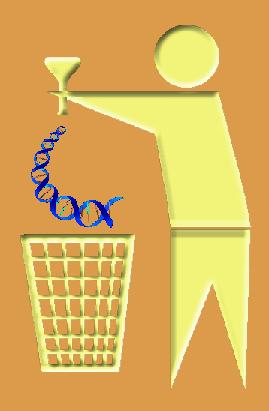 Intelligent Design
Intelligent Design
 Life Sciences
Life Sciences
Richard Gallagher Frames Intelligent Design Proponents While Rewriting the History of Junk-DNA (Part 3)
 I stated in my previous post that “ID has long-predicted that junk-DNA has function, and ID was right.” So what has Neo-Darwinism done with respect to “junk”-DNA? The Panda’s Thumb post cited by Richard Gallagher in his recent attack on ID in The Scientist cites an ID-proponent that found that some Darwinian biologists predicted that “junk”-DNA would have function, and the implication is that Neo-Darwinism has not forestalled research into “junk”-DNA.
I stated in my previous post that “ID has long-predicted that junk-DNA has function, and ID was right.” So what has Neo-Darwinism done with respect to “junk”-DNA? The Panda’s Thumb post cited by Richard Gallagher in his recent attack on ID in The Scientist cites an ID-proponent that found that some Darwinian biologists predicted that “junk”-DNA would have function, and the implication is that Neo-Darwinism has not forestalled research into “junk”-DNA.
So what if some biologists did buck the trend and investigate function for non-coding DNA? Good for them for being observant, and good for them for not relying upon the neo-Darwinian consensus! The fact remains that the entire false “junk” DNA paradigm was born out of the neo-Darwinian mindset, which taught that cells were constantly subjected to random evolutionary forces and genetic parasites that littered the genome with “junk.” There is no denying that the whole dead-end concept of “junk”-DNA came from the Neo-Darwinian paradigm, and that’s what matters here.
I discussed a few examples of Darwinian biologists proclaiming the lack of function for “junk” DNA in a previous post:
In 1994, the authoritative textbook, Molecular Biology of the Cell, co-authored by National Academy of Sciences president Bruce Alberts, suggested (incorrectly!) that introns are “largely genetic ‘junk'”:
Unlike the sequence of an exon, the exact nucleotide sequence of an intron seems to be unimportant. Thus introns have accumulated mutations rapidly during evolution, and it is often possible to alter most of an intron’s nucleotide sequence without greatly affecting gene function. This has led to the suggestion that intron sequences have no function at all and are largely genetic “junk”…[2]
Soon thereafter, the 1995 edition of Voet & Voet’s Biochemistry textbook explained that “a possibility that must be seriously entertained is that much repetitive DNA serves no useful purpose whatever for its host. Rather, it is selfish or junk DNA, a molecular parasite that, over many generations, has disseminated itself throughout the genome…”[3]
In 1996, leading origin of life theorist Christian de Duve wrote: “The simplest way to explain the surplus DNA is to suppose that it is a parasite or at best a harmless but useless passenger, hitching a ride in the survival machines created by the other DNA.”[4] Another leading biologist, Sydney Brenner argued in a biology journal in 1998 that: “The excess DNA in our genomes is junk, and it is there because it is harmless, as well as being useless, and because the molecular processes generating extra DNA outpace those getting rid of it.”[5]
Finally, as I’ve discussed multiple times before, in 2003 John S. Mattick, director of the Institute for Molecular Bioscience at the University of Queensland in Brisbane was quoted in Scientific American explaining that introns “were immediately assumed to be evolutionary junk” but then said that this may have been “one of the biggest mistakes in the history of molecular biology.” There’s no question that the neo-Darwinian paradigm generated the false “junk”-DNA paradigm and perpetuated it far beyond its natural life expectancy.
Again I ask, so what if some Darwinian biologists bucked the clear consensus that under Neo-Darwinism, the “excess” DNA was probably useless junk? As Dembski would say, emphasizing such biologists is an exercise in stressing irrelevancies. The important fact is that the false “junk”-DNA paradigm was born and bred within the Neo-Darwinian mindset. You would never catch a clear-thinking ID-proponent saying something like, “The simplest way to explain the surplus DNA is to suppose that it is a parasite or at best a harmless but useless passenger, hitching a ride in the survival machines created by the other DNA.”
I Saw It with Mine Own Eyes
It’s tough to beat the testimony of an eyewitness. In this case, I am an eyewitness to the fact that Darwinian biologists contended that types of non-coding DNA were “junk” that couldn’t possibly have been designed. In 2000 I took a graduate seminar at Scripps Institution for Oceanography where my fellow classmates argued to me that our DNA was not designed because Alu repeats could not possibly be anything but “junk.” Then in 2003, Hakimi et al. published in Nature, “A chromatin remodeling complex that loads cohesin onto human chromosomes,” which reported function for human Alu sequences. Indeed, Richard Gallagher’s article now provides a discussion of the functions for Alu repeats:
It’s been all downhill [for junk-DNA]. Since, undermined by discoveries of the complexity of gene structure, the sophisticated nature of translational controls (which includes a role for Alu repeats, on the face of it the most meaningless junk of all), and the reach and scope of transposons. Recently, and damningly to the concept of junk, we’ve had the revelation of regulatory RNA networks.
(Richard Gallagher, “Junk Worth Keeping,” The Scientist, Vol. 21(7):15 (July, 2007).)
Gallagher’s discussion of Alu repeats defeats his own argument. Gallagher admits that there is “a role for Alu repeats” that are “on the face of it the most meaningless junk of all.” (emphasis added) Gallagher’s comment would not be possible were it not for the historical fact that a lot of Darwinian biologists had wrongly assumed non-coding DNA was largely “junk.”
